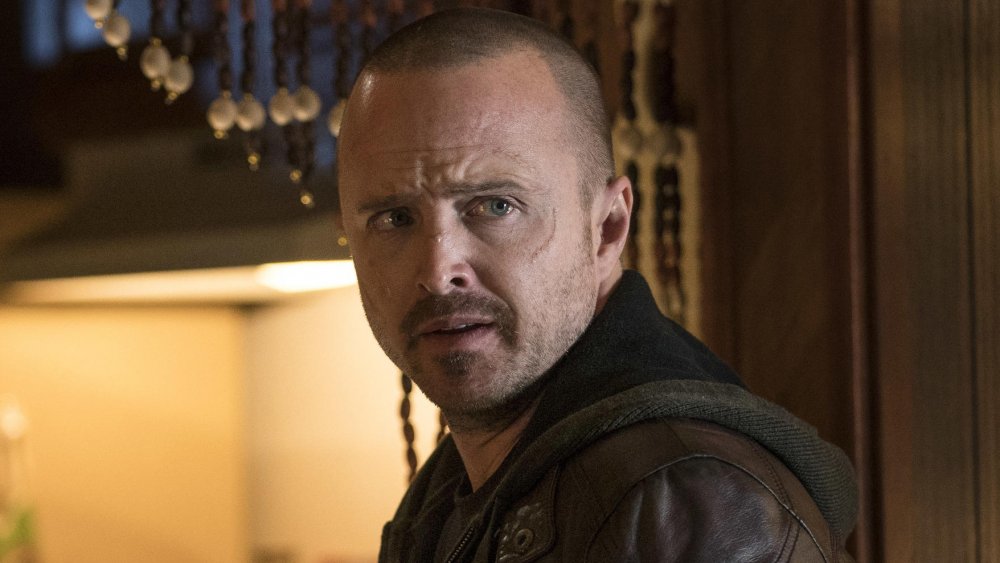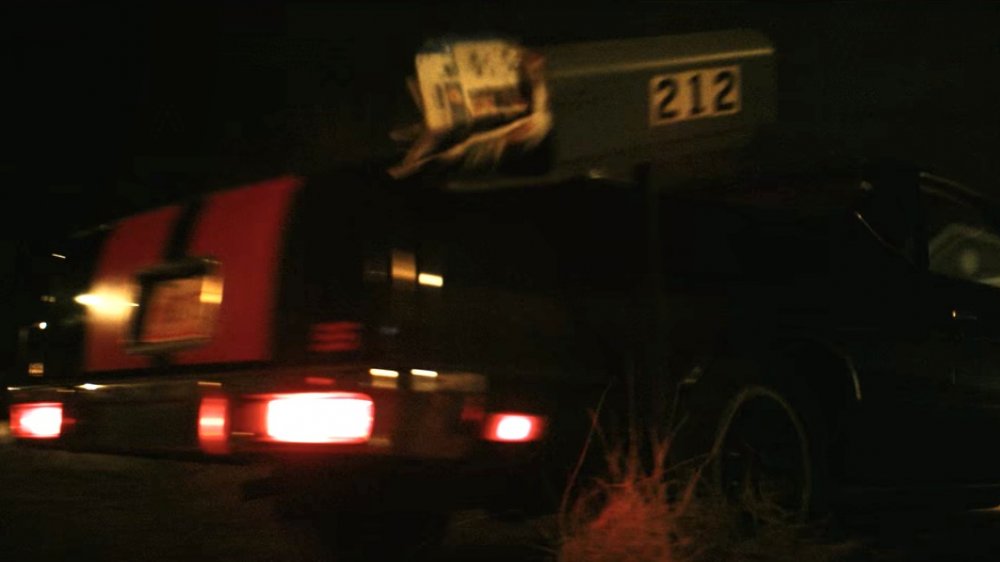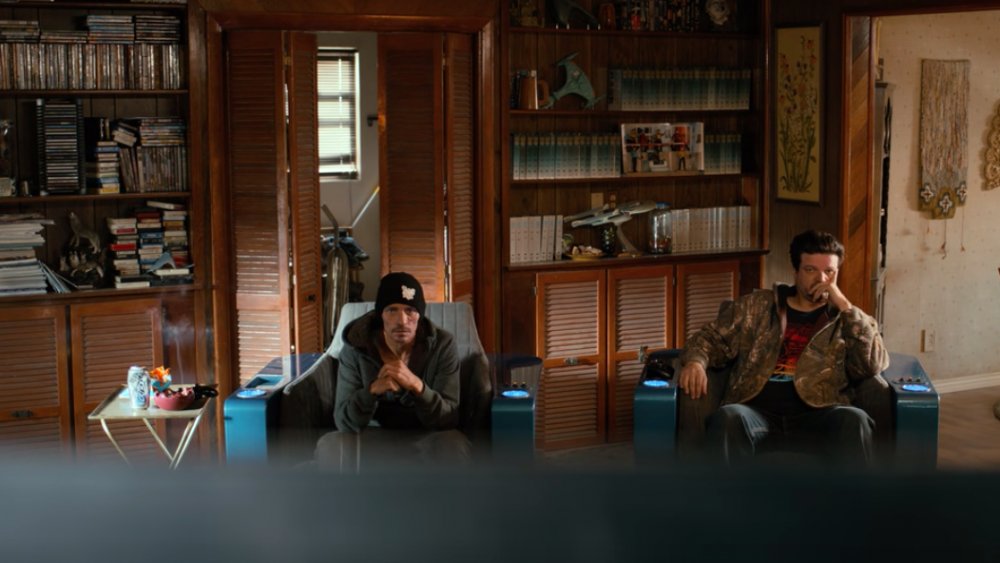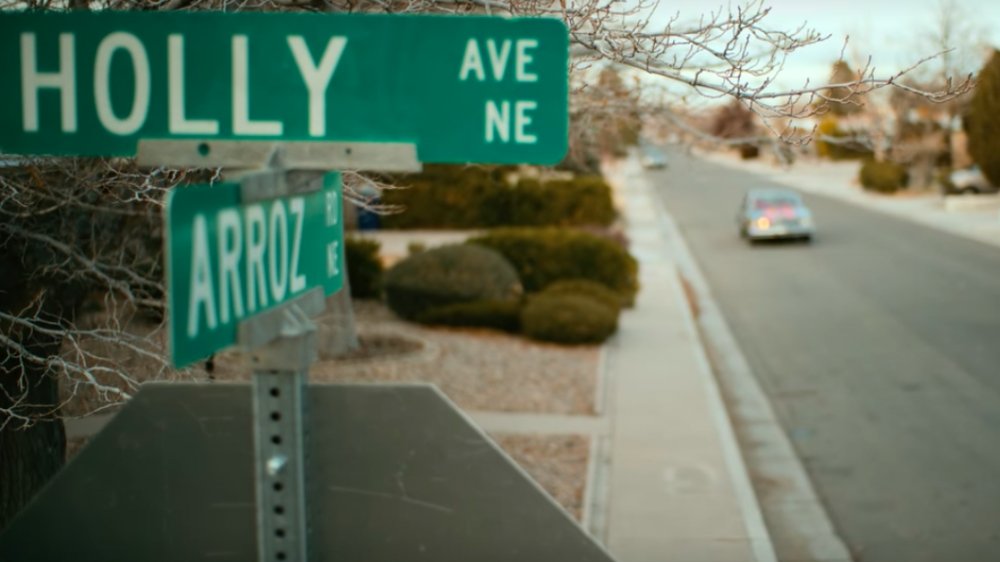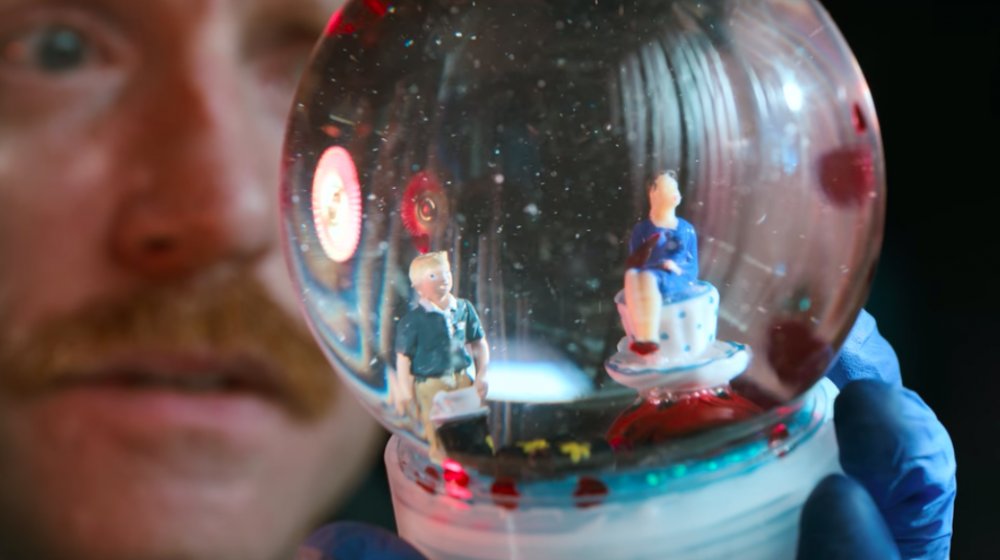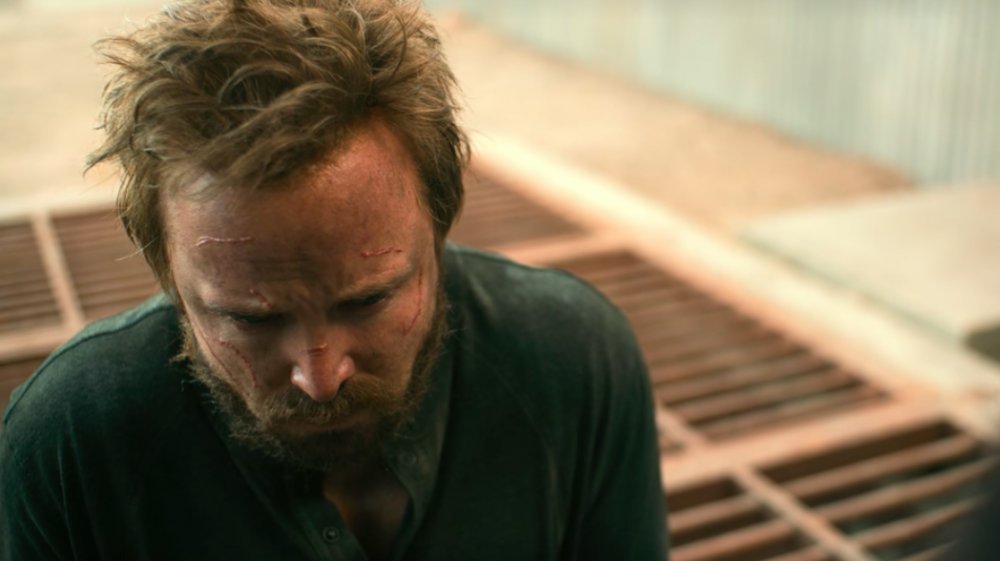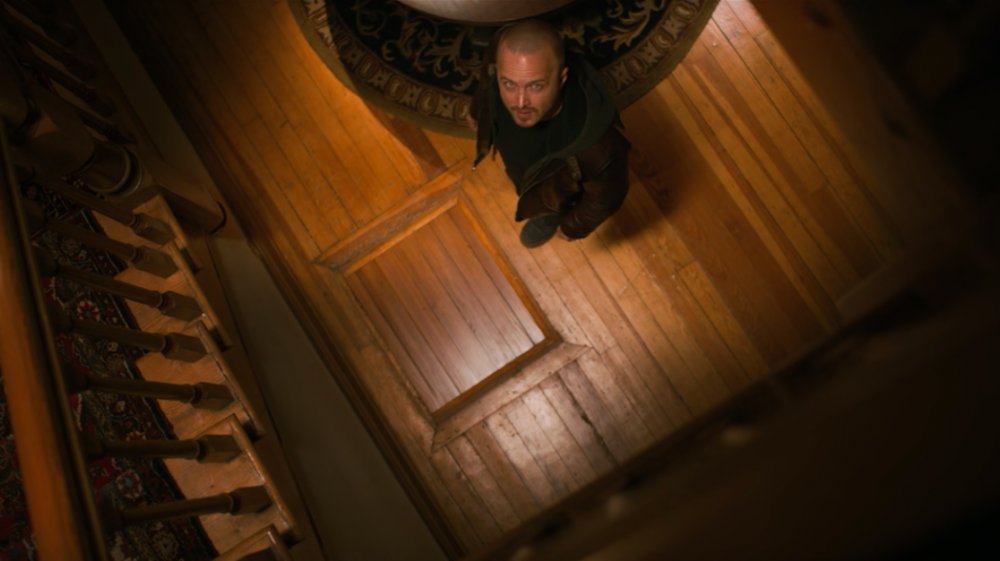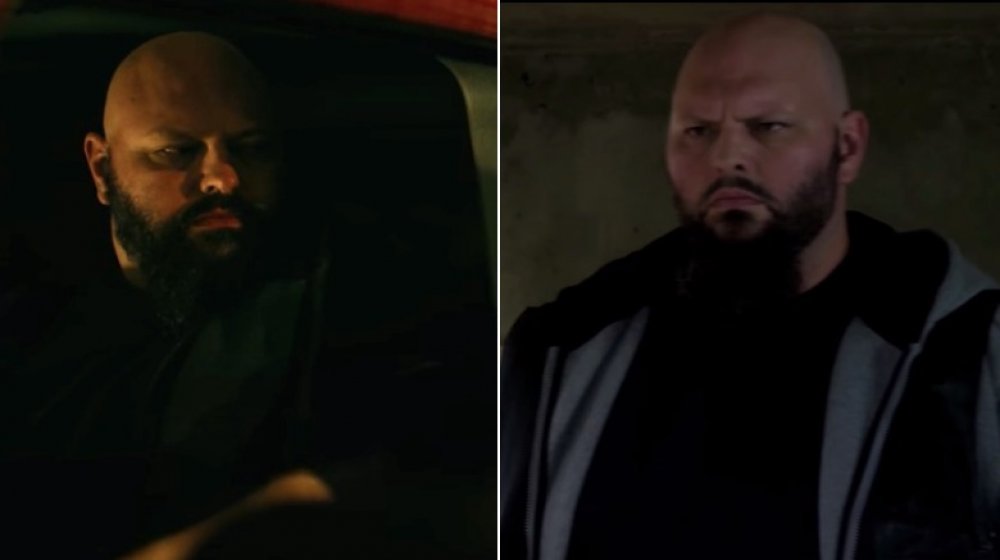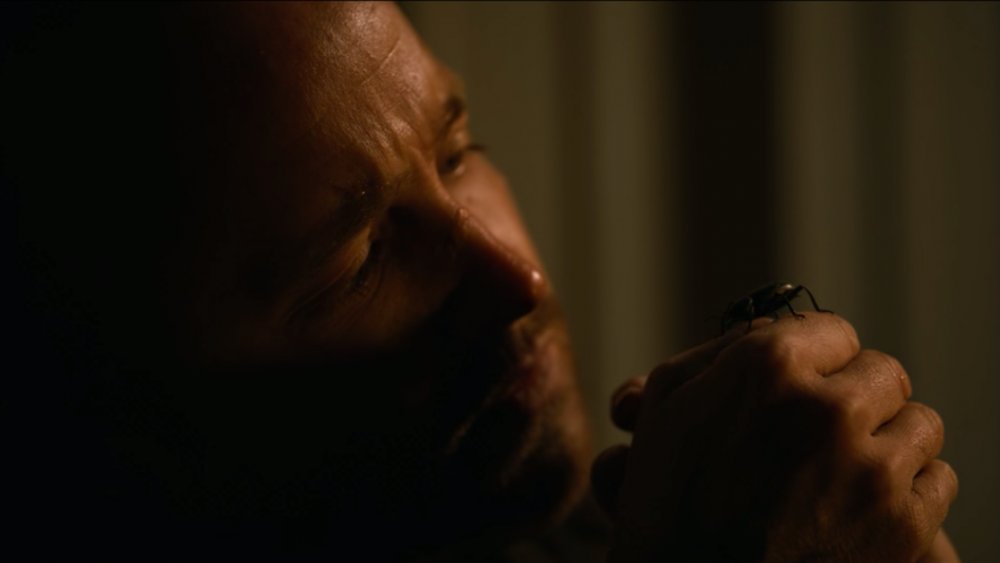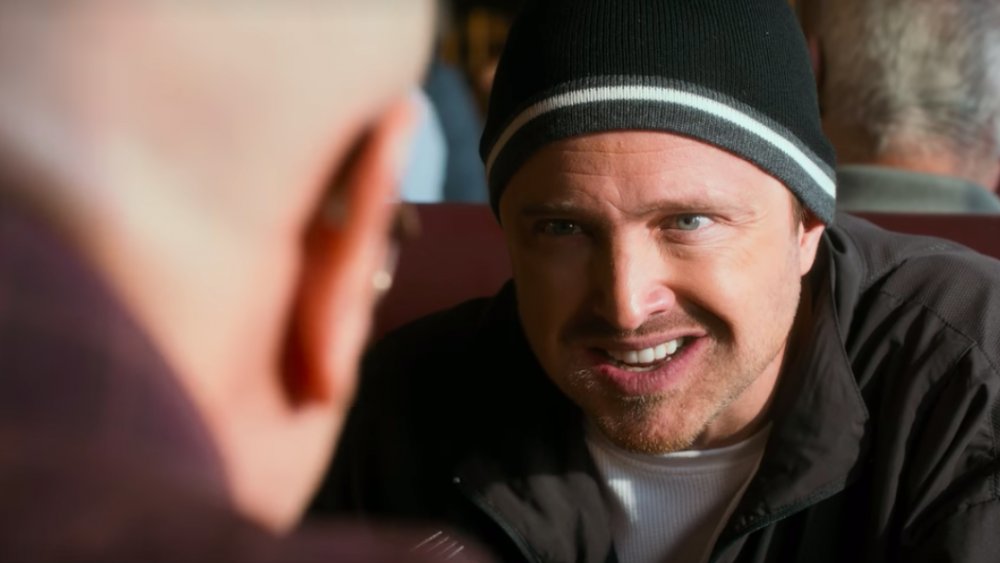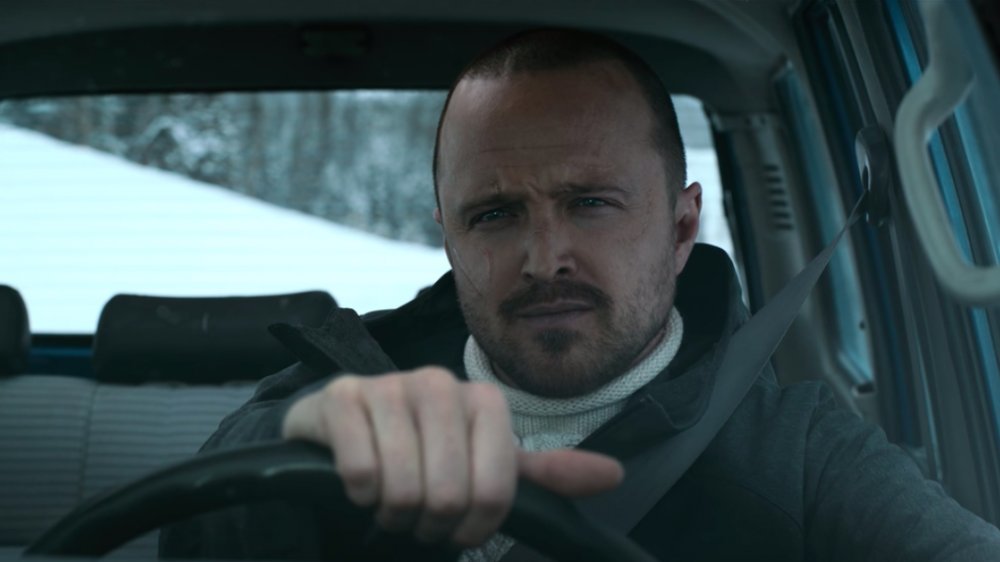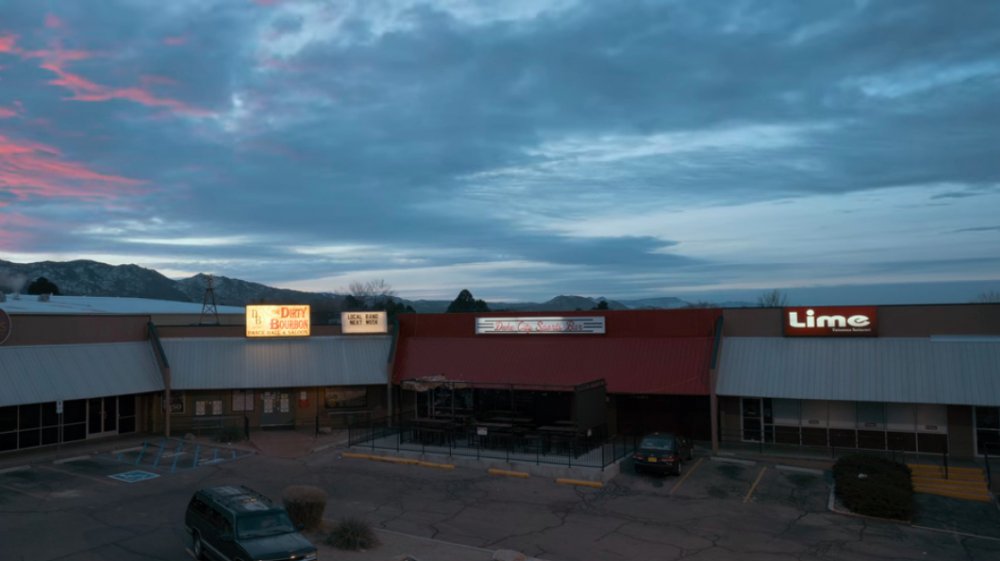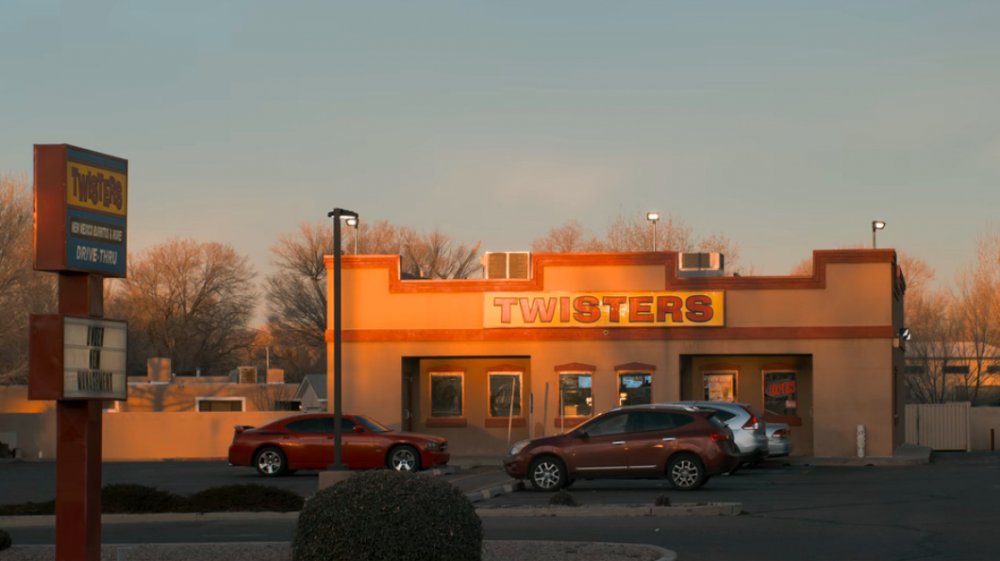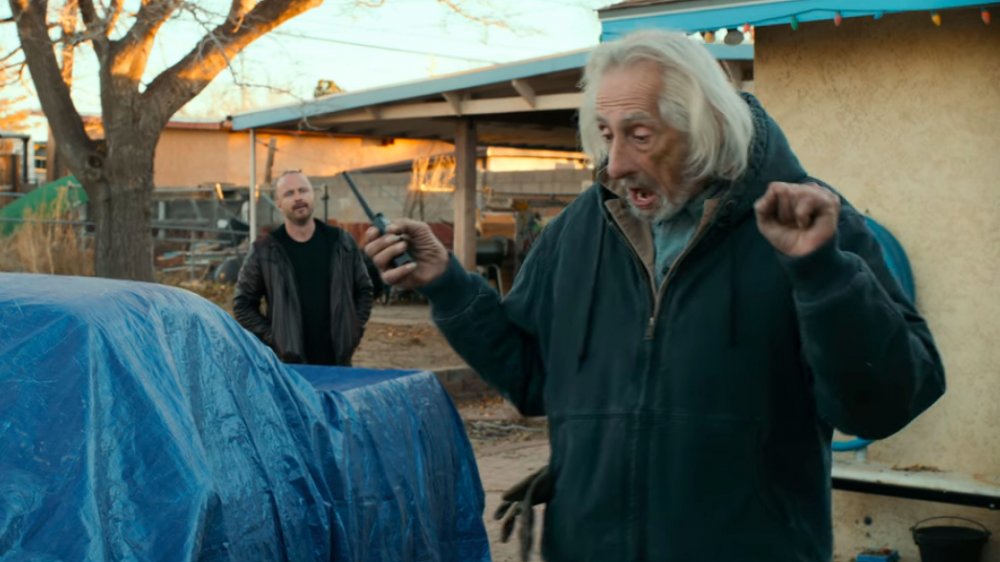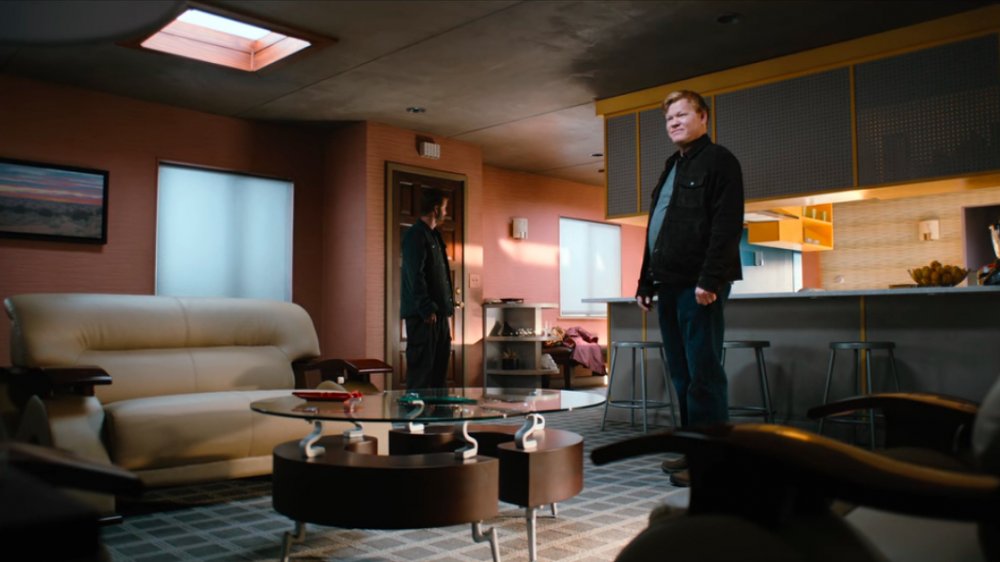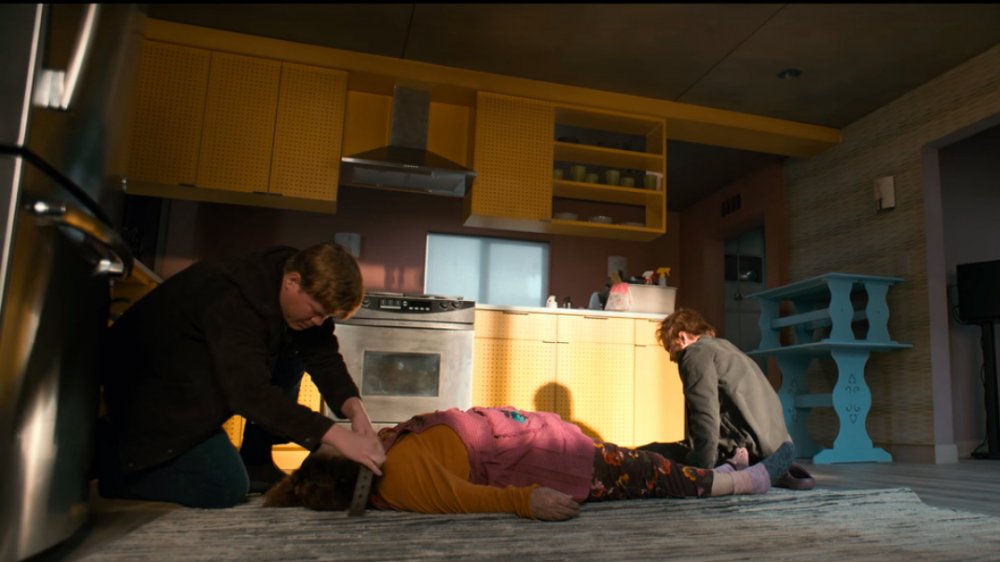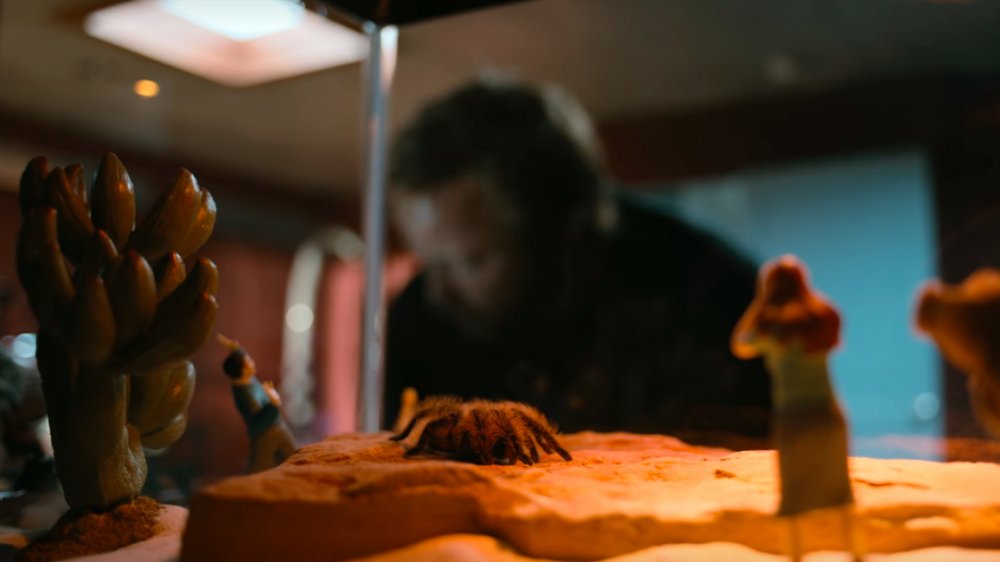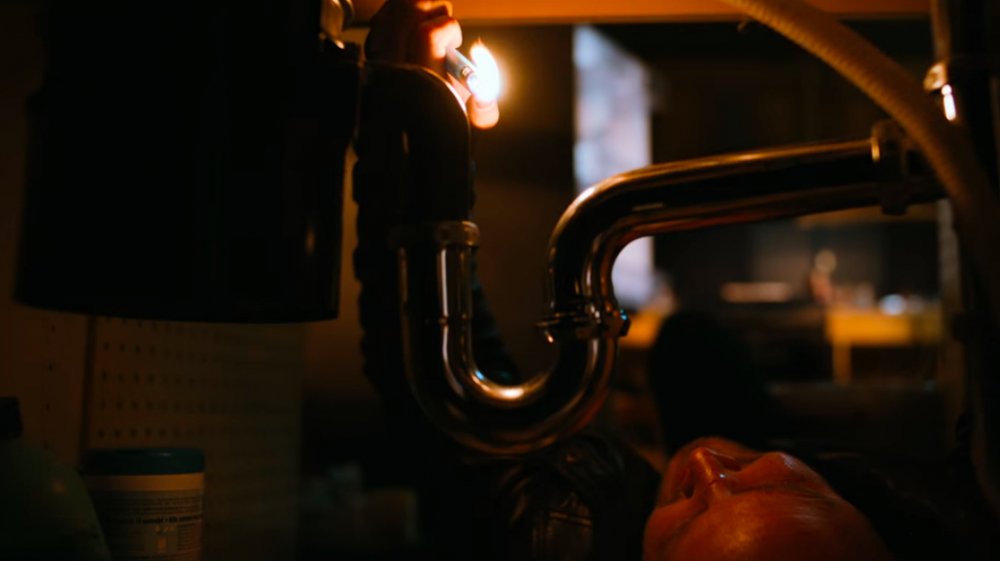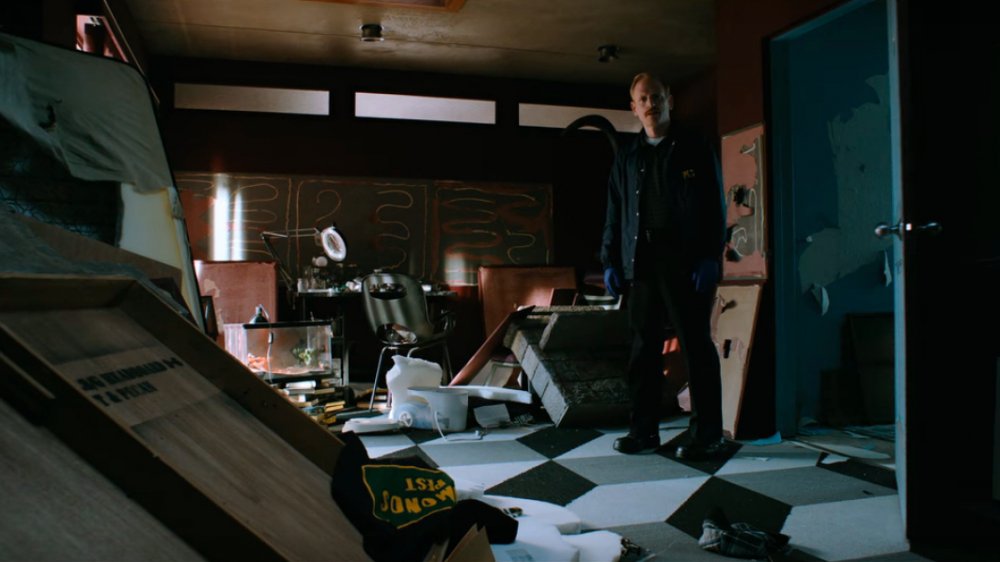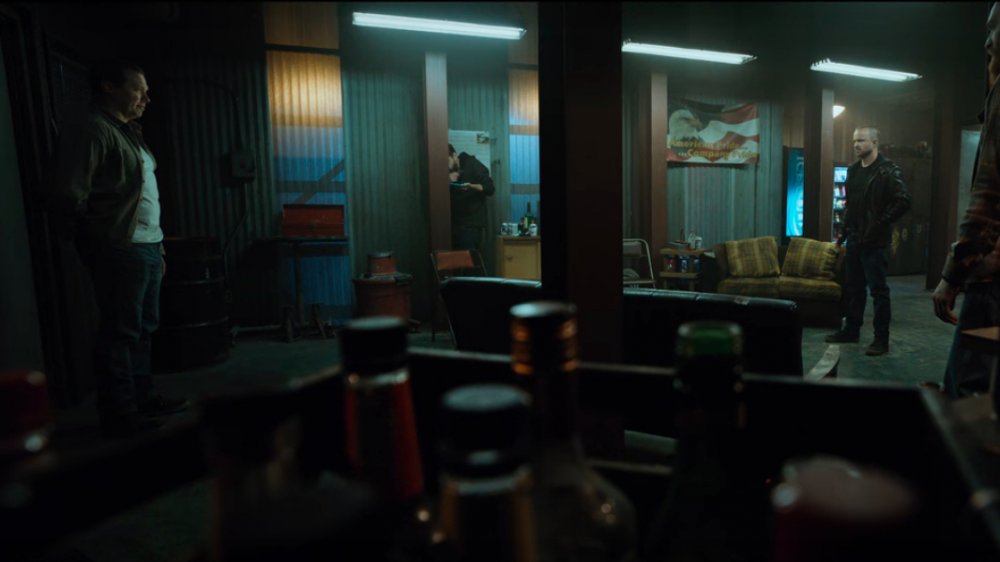Easter Eggs You Missed In El Camino
Breaking Bad was always a series designed to reward close viewings. By the time it wrapped up, it was agreed that one of the show's critical strengths was its clockwork-like attention to detail. Everything about the show seemed to be there with clear purpose, making it a rare series without much in the way of plot holes, dropped storylines, or extraneous scenes, and that's a trend that continues in the sequel story El Camino.
When the acclaimed final episode of Breaking Bad, "Felina," premiered in September 2013, it decisively concluded the saga of Walter White. It was something of a ghost story, following Walt in a new identity as he poked through the ashes of his old life, tying off some loose ends and leaving him with some semblance of victory. But the fate of Jesse Pinkman was left unknown, leaving viewers with a sliver of hope for his future but no details.
Now, El Camino: A Breaking Bad Movie is here to fill in the blanks, serving as a final character study for the series' other leading man. Did Jesse get away with his freedom and his life? Did Mr. White, the devil himself, stay dead? And how many references are hidden throughout the film? Well, let's delve into the details and dig up some Easter eggs you may have missed in Breaking Bad's grand epilogue, El Camino.
A mysterious mailbox
El Camino begins with a flashback of Jesse and Mike Ehrmantraut making conversation about where they might escape to if they ever ended up as fugitives. Mike is clear in his answer: Alaska, "the last frontier." By the time we catch up with Jesse screaming down the road after the events of Breaking Bad, it's clear he's had escape to the great white north on his mind for awhile.
But Jesse's dash for freedom is almost immediately derailed by the swift arrival of some police officers, alerted to the Nazis' compound by the pounding hellfire of Walt's military-grade coup de gras. Seeing the red and blues approaching, Jesse swerves his car into a driveway, laying low with the lights off as the police pass. When they do, he backs out swiftly, knocking over a mailbox and sending junk mail flying. But the mailbox doesn't sail out of frame — it hangs there, holding in the corner of the shot as Jesse flees, with the address number "212."
The number has significance in Jesse's story. "Phoenix," the twelfth episode of Breaking Bad's second season, can be rendered as episode 212. That's the episode that sees Jane die, a turning point in Jesse's life that takes him from a bad situation to true, prolonged misery. Considering that one of El Camino's last scenes is a flashback of Jesse and Jane, this shout-out to the moment that their budding romance ended seems suitable.
The final frontier
Over the course of their time on Breaking Bad, Skinny Pete and Badger proved themselves to be surprisingly adorable. While it would be easy to write the two off as layabouts perpetually in the process of getting their lives together, the show imbued them with peculiar interests and surprising depths, from Skinny Pete's showstopping piano skills to the duo's abiding passion for sci-fi.
In the season five Breaking Bad episode "Blood Money," Skinny Pete and Badger have an extended dialogue about Star Trek, with Pete spinning theories about how transporter tech works and Badger pitching his own episode of the show.
In a later episode, "Rabid Dog," Walt meets with Saul Goodman and his associate Patrick Kuby in an effort to locate the fugitive Jesse. Kuby then explains that he posed as a meter reader to plant a bug in Badger's mom's house, hoping to overhear some intel on Pinkman's whereabouts. Unfortunately, he only managed to hear three hours' worth of Pete and Badger prattling on about Babylon 5. (We want to see that deleted scene.)
With that background in mind, it's a real pleasure to see Skinny Pete's house so decked out in Star Trek paraphernalia, from starships on the bookshelves to sci-fi inspired chairs in front of the TV. It's just another detail to further flesh out characters we thought we already knew, showing how their addictive personalities can be put toward interests way more wholesome than what you'd find at the end of a meth pipe.
Crossroads of love in El Camino
One of the more obscure Easter eggs in El Camino doesn't require an extensive knowledge of Breaking Bad and Better Call Saul, so much as it relies on the viewer's knowledge of the show's creator, Vince Gilligan. But what Breaking Bad super-fan wouldn't love him? The charming and folksy showrunner has come to inspire great loyalty in the people that he works with, but he also draws similar praise from fans of his work. Apart from the quality of his art, that fandom seems to be partly owed to the fact that he's proven so willing to engage audiences with callbacks and references, nodding to the viewer in a way that says, "Hey, we know you're watching, and we appreciate it."
But in El Camino, one of those nods is a lot more personal. As Todd is driving Jesse to his apartment to help with an ambiguous but foreboding errand, the car passes by the intersection of Holly Avenue and Arroz Lane. Holly, of course, was the name of Walter and Skyler White's daughter, the newborn whose future security so motivated Walt's twisted turn toward crime. But Holly's name was itself a reference to a real-life figure: Vince Gilligan's longtime girlfriend, Holly Rice, with "Rice" translating — quite suitably, considering the setting — to the Spanish word "arroz."
A creepy nod to Todd and Lydia
Of all people, who would've thought the Breaking Bad movie would spend so much time on Todd? One of the most loathsome villains in a series that had plenty of those to go around, Todd returns in El Camino in extra large fashion, with an extended flashback of a dreadful weekend Jesse spent in his company. With the series already having firmly established Todd as a truly cold-hearted psychopath, El Camino delves into just how weird he is, in skin-crawling detail.
With his apartment full of serial killer-esque trophies, sparse decor, and an actual dead person, Todd in El Camino comes off like a combination between Jeffrey Dahmer and that kid from St. Elsewhere. The most perplexing objects in Todd's home can be found in his collection of strange, apparently hand-made snowglobes. While they'd be innocuous and kitschy as decor for your average kindergarten class, they come off as eerie, even sinister, in the context of Todd's apartment.
The most insidious example of Todd's craftsmanship is the one held up by the faux police officer just before a cornered Jesse makes himself known. The snowglobe seems to show a representation of Todd locked in a winter wonderland with Lydia, the high-powered operative in the global meth scheme whom Todd developed an unsettling fascination with during the series. Keeping to what Todd knows about her, she's shown literally submerged in a giant teacup, frolicking while Todd watches. We don't mean to be controversial, but we're really glad that guy is dead.
Jesse's dogged determination
Breaking Bad is a show that loves its motifs, whether it's a one-eyed pink teddy bear floating in the pool or the sky blue color of methamphetamine, memorial ribbons, and so much else. Another one of the series' minor motifs is the dog metaphor — with different characters being described as canines — adapted to relate to whatever is happening in the story at the time. In season four, the deceased Gale Boetticher is described euphemistically as a problem dog who needed to be put down by Jesse for being an inconvenience. In season five, the unhinged, revenge-focused Jesse is referred to as a sort of "rabid dog" that needs to be killed for posing a threat to Walter. And finally, after Walt acquiesces to defeat and flees Albuquerque, a single stray dog crosses the street on the road behind him, all alone.
El Camino brings the dog motif back in a truly disturbing way in the dynamic between Jesse and Todd, who further proves his creepiness through the way he treats his prisoner during their weekend out. On multiple occasions, from the gentle pats on Jesse's head to the remarks about keeping him better groomed, Todd reveals that he thinks of Jesse as nothing more than a domesticated animal, one he can handle with the promise of treats should he ever turn feisty. It's deeply unsettling, and it speaks to the depths of abuse Jesse suffered during his captivity that the series proper only ever hinted at.
That crawl space in El Camino
Jesse's escape from Albuquerque in El Camino is a long and arduous process, more resource-gathering and table-setting than an all-out sprint out of town. When Jesse returns to his parents' home, sneaking in with a hidden key after luring them off of the premises, he makes a beeline to a locked safe, working to retrieve some old guns for a coming conflict.
As he makes his way through the house, he briefly stops by the stairs to look up toward the second story, where the safe lies at the floor of a closet. When he pauses to look up, he's standing over an evident crawl space, outlined in the floorboards.
Jesse would have no way of knowing this, but a crawl space just like this one played host to one of the most iconic shots in the entire series ... and one of the lowest points in Walt's criminal career. In the "Crawl Space" episode, Walt ended the hour literally sunken under ground, his face framed by the rectangular entrance until the floor of the house looked like a kind of open casket. The famous shot had intense implications for the story to come. Walt, it seemed, was a dead man.
Notice how Jesse doesn't have any business in the crawl space of his own family's home. When Walt was backed into a corner, he sank into the ground. Finding himself in a similar situation, Jesse keeps his eyes up and ascends the stairs, getting one step closer toward freedom.
Better call Clarence
During the lead-up to the release of El Camino, questions were raised as to just how much of the Breaking Bad universe you would need to have experienced in order to get something out of the movie. Seeing Breaking Bad itself seems like a given, but many people wondered if they would have to be caught up on Better Call Saul. And rightly so. It's a good show, but one that's easy to sleep on.
Vince Gilligan was asked this very question during an interview with The Hollywood Reporter. While he had hopes that the dramatic stakes would be clear enough to engage total novices, he did agree that it's a better movie for a fan of the series. "By all means, see Breaking Bad first," he said. "Better Call Saul ... not as much."
You can't say the man lied to you. However, there is at least one Better Call Saul reference tucked away in El Camino, working to further establish this fictional Albuquerque as a living, breathing place.
When Jesse arrives for his final confrontation with Uncle Jack and Todd's affiliates, he has to wait patiently as the group is entertained by a group of strippers, brought to the location by a bodyguard named Clarence. This is the same Clarence who proved to be uniquely unfit for bodyguard duties during a previous encounter with Mike in the Better Call Saul episode "Pimento," where he was only referred to by his size, rather than his name.
Bugging out
When Breaking Bad first started, it was easy to see Walter White as a good man with his back against the wall and Jesse Pinkman as his amoral, necessary foil. Oh, how that perspective changed by the end. One of the ways in which the audience learned to view Jesse with compassion was in the way he himself was compassionate toward those around him, particularly children and animals. Even typically loathsome creatures like creepy-looking insects were treated kindly by Jesse, as was shown in the season two episode "Peekaboo."
That episode involved Jesse going off on his most arduous solo mission to date, fending off violent, far-gone methheads as he attempted to also do right by their sorely neglected child. Before that episode took off, though, Jesse whiled away the time by letting a large black bug crawl onto the back of his tattooed hand, regarding it with a smile as it crawled around his fingers. (That Skinny Pete then immediately moved to crush the bug seems to have done little harm to their abiding friendship.)
El Camino makes a reference to this scene as Jesse waits for the strippers to leave before his final attack on the neo-Nazis' associates, letting a similar bug crawl onto his hand. He regards it closely this time, keeping his thoughts private. Whatever he's thinking, it's likely that bugs like these were among his only companions during his long months in captivity. At least they're not houseflies, though. On Breaking Bad, flies drive you crazy.
Breaking bread with Walter White
The one question everyone had on their minds going into El Camino's mysterious release was simple: "Are we going to see any Walt in this thing?" While few really thought the bullet-riddled Mr. White would be coming back to life — that'd be more "El Monstruo" than "El Camino" — it was wondered whether or not Bryan Cranston would be back in the role in a flashback and a bald cap.
The answer to both questions turned out to be "yes" — a somewhat obvious yes, in the case of the bald cap. From the clothes that they're wearing and their general demeanors, Jesse and Walt's flashback scene seems to take place immediately after they've found their way back to civilization after being stranded in the acclaimed season two episode "4 Days Out." The scene features plenty of fan service — one last triumphant "yeah, b—-" from Jesse as he raids a salad bar, more of Walt and Jesse's warm-at-times father-son relationship, and one final insult from the aloof and condescending Walt, who forgot Jesse even graduated high school.
During their discussion, Jesse and Walt get into the mildest of disagreements about the value of pineapple, which Walt can take or leave. Jesse claims it's good for you, "full of bromine," which Walter corrects to "bromelain." While Jesse's attempt at trivia is, as Walt says, not even close to being right, it is a reference to the chemical element that forms the "Br" in Breaking Bad's memorable title card.
The way forward at the end of El Camino
When it was first announced as the official title of the mysterious, shot-in-secret Breaking Bad movie, the name "El Camino" struck many as only deepening the mystery. It was unexpected. What could it mean?
Obviously, "El Camino" is most known as a classic car from Chevrolet, with the hood stripes on some models forming the basis for a few of the Breaking Bad movie's promotional posters. It's specifically the model of car Jesse uses to flee from the Nazi camp, but he doesn't hold onto the car for that long. Instead, it remains stowed at Skinny Pete's place as part of an improvised plan to keep Jesse safe. After the first 15 minutes, it's barely in the movie anymore. So what gives?
Well, Breaking Bad was always a series that enjoyed playing around with titles. Like in season two, the titles of each of the ominous plane crash flashforward episodes ultimately spelled out "737 Down Over ABQ." And then there's the last episode of the show, "Felina," which is both an anagram of "finale" and a reference to the Marty Robbins song that scores a critical part of the episode. And translated into English, "el camino" means "the way," which is a turn of phrase as open to interpretation as Jesse's original fate. He spends the movie looking for a way out of his predicament, and a way forward in his life, perhaps ending up, as Aaron Paul told us so many years ago, as a carpenter living quietly in Alaska.
Saul Goodman & Associates is now Duke City Sports Bar
Beginning in the second season of Breaking Bad, Walt and Jesse were frequently aided and abetted in their illegal misdeeds by crooked lawyer Saul Goodman, who operated out of an unassuming office located in an Albuquerque strip mall. At the end of the series, Saul abandoned his legal practice and ran for his life, starting over with a new identity in Nebraska, courtesy of Ed "the Disappearer" Galbraith, and the character didn't make an appearance during El Camino.
But if you look closely, there is a brief callback to Saul early on in the film, during the night Jesse spends crashing at Skinny Pete's house. In a series of brief time-lapse shots showing the sun rising over Albuquerque, we're treated to three shots of different locations in the city. The second shows a nondescript strip mall, but if it looks familiar, there's a reason for that. One of the businesses shown is Duke City Sports Bar, which resides in the same location that used to house Saul Goodman & Associates. We can only hope the owners of Duke City wind up faring a little better there than Saul did.
The real-life Los Pollos Hermanos
Gus Fring is long dead by the time El Camino rolls around, murdered by Walt at the end of the season four Breaking Bad episode "Face Off." After politely terrorizing Walt and Jesse for two seasons, all while keeping up appearances as the respectable proprietor of the fast food chain Los Pollos Hermanos, Gus met his grisly end when Walt teamed up with Hector Salamanca (Mark Margolis) to lure him into an explosive trap.
While several other characters who perished over the course of Breaking Bad still managed to make an appearance in El Camino, Gus is not among them. However, there is a blink-and-you'll-miss-it nod to Breaking Bad's greatest antagonist in the same early morning sequence when we glimpse Duke City Sports Bar. Right after the camera reveals the new business occupying Saul's former office space, it shows a fast food restaurant named "Twisters."
Twisters is in fact a real-life restaurant in Albuquerque, which provided both the interior and exterior shots for Los Pollos Hermanos in Breaking Bad. In El Camino, it would seem that the fictional restaurant has since morphed into its real-life counterpart.
A magnetic callback
Although Walter White did most of the intellectual heavy lifting throughout the course of Breaking Bad, Jesse occasionally came up with a few winning ideas of his own. One of his best plans was cooked up in the season five episode "Live Free or Die," when Jesse suggests that instead of attempting to break into the evidence locker of the Albuquerque Police Station to steal Gus Fring's (Giancarlo Esposito) laptop, which contains incriminating information that could be used against Walt and Jesse, they simply wipe the laptop using a powerful electromagnet Old Joe (Larry Hankin) uses to move wrecked cars at the junkyard.
In El Camino, Old Joe reminisces fondly of the "business" Jesse and Walt gave him back in the day, chuckling as he raises his fists in an imitation of Jesse and calls out, "Magnets!" Unfortunately, shortly after that, Joe realizes that the LoJack system on Todd's car has been activated and hightails it out of there before the police arrive, leaving Jesse with the car. Still, it seems fitting that in a movie where Jesse is the star, one of the first callbacks it makes is to one of his greatest moments.
Todd's decorating scheme
Considering Breaking Bad's reputation for sprinkling clues and meta references throughout its episodes, most viewers likely went into El Camino expecting much of the same, prepared to watch closely so as to not miss anything. However, it still came as an amusing surprise when El Camino not only delivered on the Easter egg front, but explicitly called them out in the setting that proved to be the richest when it came to subtle self-referential nods and callbacks.
During a flashback to Jesse's time in captivity, Todd (Jesse Plemons) takes him to his apartment as he works through his to-do list of extremely disturbing errands. As Jesse stands uneasily in the doorway of Todd's abode, his host asks him what he thinks of his place. Jesse offers that it's "nice, kinda pastel," to which Todd responds, "I was thinking of Easter eggs."
At first glance, the line seems pretty innocuous — as are the vast majority of the things Todd says — but it's hard to imagine Vince Gilligan wrote in a literal mention of Easter eggs without considering how the term has long been used in pop culture. Most likely, Todd's line is a wink to the audience, letting us know that Gilligan is aware that we're all watching closely, and that our efforts will be rewarded.
Sonia's portentous fate
Poor Sonia, we hardly knew ye. After asking Jesse to help him install the cover on his El Camino, Todd reveals why that was necessary when he takes Jesse to his apartment and shows him the body of his cleaning lady, Sonia (Gloria Sandoval). Sonia, who in the words of Todd's chillingly banal eulogy was a "nice nice lady" and an "excellent housekeeper," had been going about her tasks when she came across one of the hollowed out encyclopedias Todd used to hide his drug money. Thinking Todd didn't know it was there, she hurried to show him what she'd found, and paid for her honesty with her life. Todd's only regret? That he never learned what she was attempting to look up.
He may have been more invested in what he'd done to Sonia, though, had he realized that he would suffer a similar fate not long after, and at the hands of the man who helped him dispose of her body. Todd murdered Sonia by strangling her with his belt, which is nearly identical to the way that Jesse would eventually kill Todd. The only difference was that Jesse didn't use a belt to strangle Todd, but the handcuffs he'd been bound with — and Jesse didn't have anything nice to say about Todd following his death.
A macabre pet
One of the pivotal moments in Breaking Bad occurred in the first half of season five, on the heels of Walt and Jesse's successful train heist, which they carried out with Todd's help. While they were still riding high from the robbery, things took a sharp turn when they crossed paths with a young boy named Drew Sharp (Samuel Webb), who'd been out riding his bike in the desert and just happened to come across the criminal trio. Although the child hadn't seen them commit a crime, Todd still shot and killed him over Jesse's frantic protests, later arguing that no one was supposed to know that they'd been in the desert at all.
Before Drew was killed, the boy came across a tarantula, which he scooped up in a glass jar, presumably to keep as a pet. In El Camino, Jesse sees that Todd has a pet tarantula, which he keeps in a desert-like terrarium in his room. When he returns after Todd's death, a saddened Jesse feeds the tarantula, no doubt thinking of the child he was unable to save. Although we have no way of knowing for sure whether this is the same tarantula that Drew found, or if Todd simply decided a tarantula seemed like a good idea and went out and got his own, its presence in El Camino is undoubtedly a reference to that first deadly encounter between Todd and Jesse in "Dead Freight."
A familiar hiding place
Throughout the five seasons of Breaking Bad, characters repeatedly hid things in places where they hoped no one else would ever find them, from heating vents and crawl spaces, to vacuum cleaners and 55-gallon drums in the middle of the desert. Stashing drugs and money in creative places only to later have to move them or risk someone else finding them was a recurring motif of the show, so it was only fitting that El Camino includes its own riff on the familiar theme when Jesse rips apart Todd's apartment in search of his drug money after Todd moves it out of his World Book encyclopedias.
One of the first places Jesse looks is under Todd's kitchen sink. The location should be a familiar hiding place for eagle-eyed Breaking Bad fans, since that's where Jesse hid his stash of meth in season two's frantic "Mandala." Of course, the meticulous Todd had been a little more inventive than Jesse and had actually hidden his cash in the door of his refrigerator, but Jesse's beeline for the sink was most certainly a callback to the earlier days of the show.
Todd's former career
Before Todd was a drug dealer and casual murderer, he was an exterminator working for Vamonos Pest. While Vamonos Pest was a legitimate pest control company, its crew would often supplement their income by stealing from the houses they were fumigating, or granting access to other criminals for a price. Vamonos was eventually purchased by Walt, Jesse, and Mike (Jonathan Banks) as a front for their meth cooking operation, and as a result, Todd became increasingly entrenched in their business before turning antagonist.
El Camino includes a subtle nod to Todd's pre-Breaking Bad profession in the scene when the two Kandy Welding Company employees search his apartment for his money, pretending to be police officers. When Casey (Scott Sheperd) walks into Todd's bedroom, which Jesse had utterly destroyed in his frantic search for Todd's cash, Todd's Vamonos Pest uniform can be seen in the foreground of the shot, although the logo is only half visible. It's a stark reminder of how disastrous Heisenberg's partnership with Vamonos Pest ultimately proved to be, with Todd, Walt, and Mike all winding up dead, and Jesse fleeing to Alaska.
Jesse's "Wild West" shootout
When Jesse realizes he's $1,800 short of what he needs to start a new life, he decides that instead of asking his friends or robbing his parents, he'll instead go to the men of Kandy Welding Company, who are as deep into illegal activity as Jesse ever was. Earlier, Jesse convinced Neil Kandy (Scott MacArthur) to split Todd's money with him three ways, knowing that they both had a vested interest in not doing anything that would draw the attention of the police.
Although Jesse only asks for $1,800 — a relatively small amount, considering Neil's take was likely somewhere in the vicinity of a quarter of a million dollars — a coked-up Neil suggests that the two of them decide who gets the money in a winner-take-all old-fashioned shootout. "Like the Wild West?" an incredulous Jesse scoffs, before agreeing to the deal and winning the duel.
Breaking Bad has often been referred to as a modern-day Western, and this scene could easily be a nod to the genre that inspired much of the aesthetic of the series. However, the "Wild West" reference may be doing double duty, possibly also referring to Aaron Paul's upcoming role on HBO's Westworld, another show that offers a post-modern take on classic Western tropes. Although little is known about Paul's role on the sci-fi series, his mention of the "Wild West" in El Camino may not only be tipping his hat toward the show he's leaving behind, but also the one yet to come.
